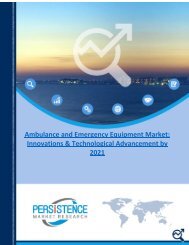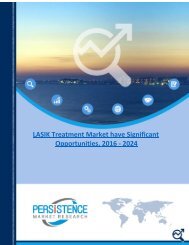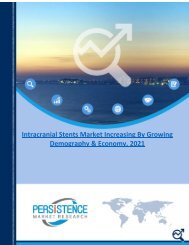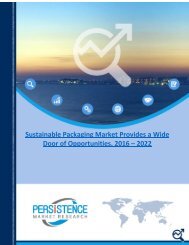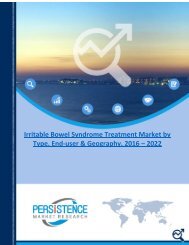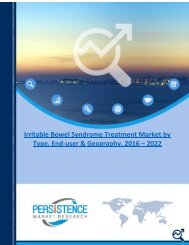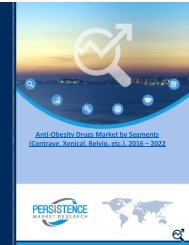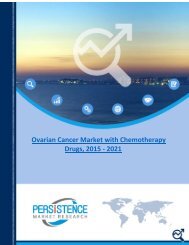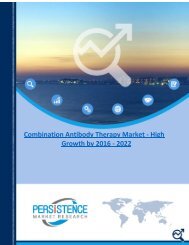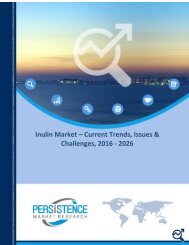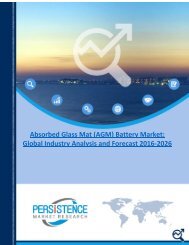Traumatic Brain Injury Therapeutics Market by Nanotechnology, 2015 – 2021
Brain tissue has one of the least self-repair capabilities making it highly vulnerable to injuries and often leading to permanent loss or disability of motor functions which dramatically reduces the quality of life for any individual.
Brain tissue has one of the least self-repair capabilities making it highly vulnerable to injuries and often leading to permanent loss or disability of motor functions which dramatically reduces the quality of life for any individual.
You also want an ePaper? Increase the reach of your titles
YUMPU automatically turns print PDFs into web optimized ePapers that Google loves.
<strong>Traumatic</strong> <strong>Brain</strong> <strong>Injury</strong> <strong>Therapeutics</strong> <strong>Market</strong> <strong>by</strong><br />
<strong>Nanotechnology</strong>, <strong>2015</strong> <strong>–</strong> <strong>2021</strong>
P e r s i s t e n c e M a r k e t R e s e a r c h<br />
About Us<br />
Persistence <strong>Market</strong> Research (PMR) is a market intelligence company, providing global business information<br />
reports and services. Our exclusive blend of quantitative forecasting and trends analysis provides forwardlooking<br />
insight for thousands of decision makers. We have an experienced team of Analysts, Researchers,<br />
and Consultants, who use proprietary data sources and various tools and techniques to gather, and analyze<br />
information. Our business offerings represent the latest and the most reliable information indispensable for<br />
businesses to sustain a competitive edge.<br />
Each PMR Syndicated Research report covers a different sector - such as pharmaceuticals, chemical,<br />
energy, food & beverages, semiconductors, med-devices, consumer goods and technology. These reports<br />
provide in-depth analysis and deep segmentation to possible micro levels. With a wider scope and stratified<br />
research methodology, our syndicated reports strive to serve clients and satisfy their overall research<br />
requirement.<br />
Copyright © <strong>2015</strong> Persistence <strong>Market</strong> Research<br />
All Rights Reserved. This document contains highly confidential information and is the sole property of PMR.<br />
No part of it may be circulated, copied, quoted, or otherwise reproduced without the approval of PMR.<br />
<strong>Traumatic</strong> <strong>Brain</strong> <strong>Injury</strong> <strong>Therapeutics</strong> <strong>Market</strong>, <strong>2015</strong> - <strong>2021</strong> Page |
P e r s i s t e n c e M a r k e t R e s e a r c h<br />
Report Media Releases<br />
<strong>Traumatic</strong> <strong>Brain</strong> <strong>Injury</strong> <strong>Therapeutics</strong> <strong>Market</strong> <strong>by</strong> <strong>Nanotechnology</strong>,<br />
<strong>2015</strong> <strong>–</strong> <strong>2021</strong><br />
<strong>Traumatic</strong> <strong>Brain</strong> <strong>Injury</strong> or TBI is sustained from severe or mild damage to the brain tissue from accidents or assaults. In<br />
North America, over 1.7 million people suffer annually from TBI and the consequent medical care costs exceed USD<br />
70 billion. According to WHO, the global incidence for TBI is close to 10 million people annually. <strong>Brain</strong> tissue has one<br />
of the least self-repair capabilities making it highly vulnerable to injuries and often leading to permanent loss or disability<br />
of motor functions which dramatically reduces the quality of life for any individual. Most neuronal damage occurs<br />
sometime after the injury takes place giving a chance for a therapeutic intervention. The previous intervention with<br />
Glucocorticoids is not considered due to their harmful effects.<br />
Request to view TOC : http://www.persistencemarketresearch.com/toc/5744<br />
A major challenge in developing therapeutics for TBI lie in overcoming the blood-brain barrier while delivering drugs. In<br />
May 2013, DARPA awarded USD 6 million to develop nanotech therapy for combating TBI to a team from University of<br />
California San Diego. <strong>Nanotechnology</strong> offers chances to overcome this physiological challenge of blood-brain barrier to<br />
deliver therapeutics. These porous silicon nanoparticles can carry a significant drug load through the blood brain barrier<br />
to treat TBI in patients. Other potential treatments include stem cell therapy for CNS trauma and use of apoE-mimetic<br />
compounds. Cognosci, a privately held start-up from North Carolina, U.S. has novel therapeutic compounds in pipeline<br />
for the treatment of TBI which the company expects to launch in coming years with a strategic partnership alliance.<br />
Currently there are two notable clinical trials for gauging the capability of progesterone for traumatic brain injury. The<br />
ProTECT III (progesterone for traumatic brain injury) is currently conducted <strong>by</strong> the Emory University and is sponsored<br />
<strong>by</strong> the NIH. The study has recruited patients from 31 TBI clinical centers across the United States. SyNAPSe, initiated<br />
<strong>by</strong> BHR, a branch of Besins Pharma, in collaboration with the American <strong>Brain</strong> <strong>Injury</strong> Consortium (ABIC) and the<br />
European <strong>Brain</strong> <strong>Injury</strong> Consortium (EBIC), is another Phase III study investigating the efficacy and safety of<br />
progesterone in patients with severe traumatic brain injuries.<br />
Since there are currently no approved therapeutic products, the sector is teeming with opportunities for new entrants<br />
as well as stalwarts of the pharmaceutical industry. Some of the notable companies developing therapeutics for TBI are<br />
Cognosci, Medicortex, Amarantus BioScience Holdings, Aldagen, NeuroScience Pharmaceuticals and Targacept.<br />
Increasing incidences of TBI due to rising assaults, accidents and military combats over the world are expected to drive<br />
the growth of the market.<br />
Key geographies evaluated in this report are:<br />
North America<br />
o U.S<br />
o Canada<br />
Europe<br />
o France, Germany, Italy, Spain, and the UK<br />
o Eastern Europe<br />
o CIS<br />
APAC<br />
o China<br />
o India<br />
o Japan<br />
o Australia<br />
o Others<br />
Latin America<br />
<strong>Traumatic</strong> <strong>Brain</strong> <strong>Injury</strong> <strong>Therapeutics</strong> <strong>Market</strong>, <strong>2015</strong> - <strong>2021</strong> Page |
P e r s i s t e n c e M a r k e t R e s e a r c h<br />
o Argentina<br />
o Brazil<br />
o Others<br />
Request to view Sample Report : http://www.persistencemarketresearch.com/samples/5744<br />
Key features of this report<br />
Drivers, restraints, and challenges shaping the <strong>Traumatic</strong> <strong>Brain</strong> <strong>Injury</strong> <strong>Therapeutics</strong> market dynamics<br />
Latest innovations and key events in the industry<br />
Analysis of business strategies of the top players<br />
<strong>Traumatic</strong> <strong>Brain</strong> <strong>Injury</strong> <strong>Therapeutics</strong> market estimates and forecasts(<strong>2015</strong> -<strong>2021</strong>)<br />
For information regarding permissions, contact:<br />
Persistence <strong>Market</strong> Research<br />
90 Sate Street, Suite 700 Albany, NY 12207<br />
Tel: +1-518-618-1030<br />
Email: sales@persistencemarketresearch.com<br />
Website: http://www.persistencemarketresearch.com/<br />
media@persistencemarketresearch.com<br />
<strong>Traumatic</strong> <strong>Brain</strong> <strong>Injury</strong> <strong>Therapeutics</strong> <strong>Market</strong>, <strong>2015</strong> - <strong>2021</strong> Page |




